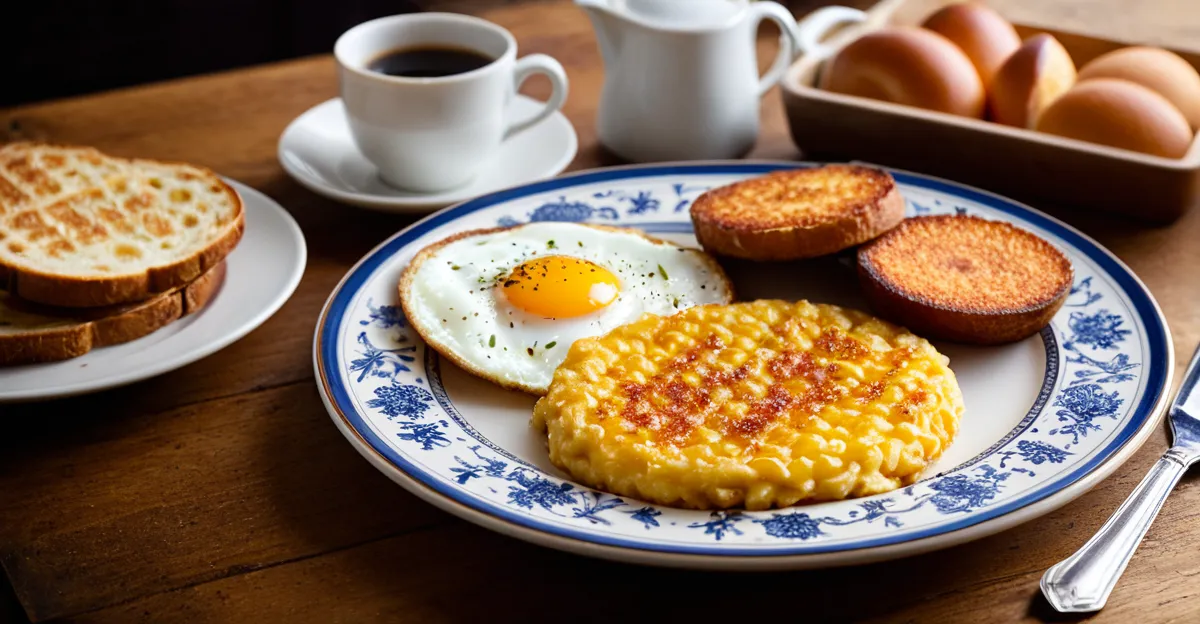Essential Traditional British Breakfast Dishes
Traditional British breakfast is much more than just a meal; it is a cultural institution reflecting a rich culinary heritage. The classic English breakfast typically features a hearty combination of ingredients that provide a balance of flavors and textures. Central to British breakfast dishes are components like sausages, bacon, fried eggs, baked beans, grilled tomatoes, mushrooms, and toast. This combination, often known as the Full English, dates back to the Victorian era when it was embraced as a substantial start to a demanding day.
Breakfast holds significant importance in British culture, often seen as the most vital meal to fuel daily activities. The robust nature of the traditional British breakfast dishes symbolizes warmth, comfort, and hospitality. It is also commonly associated with leisurely weekend mornings or special occasions that bring families together.
Additional reading : What are the key steps to making a classic bubble and squeak?
Within the UK, regional variations of traditional British breakfast exist, adding unique local flavors to the classic formula. For instance, in Scotland, black pudding and tattie scones are popular side additions, while in Wales, laverbread (seaweed paste) sometimes appears on breakfast plates. Northern Ireland may feature soda farls alongside the usual components. These regional differences highlight the diversity within British breakfast traditions while maintaining the essence of a filling morning meal.
Full English Breakfast: Ingredients and Preparation
The full English breakfast is a beloved staple of British cuisine, known for its hearty and satisfying nature. To make a classic English breakfast, you’ll need key ingredients that encompass a range of flavors and textures: sausages, back bacon, fried eggs, grilled tomatoes, mushrooms, baked beans, and toasted bread. Each component plays an essential role in creating the iconic plate.
In parallel : What are Some Unique UK Cooking Traditions and Their History?
Start by frying the sausages and bacon to a golden, crispy finish while keeping the meat juicy. Eggs can be fried, scrambled, or poached according to preference, though fried eggs are most traditional. Grilled tomatoes and mushrooms should be cooked until tender but not mushy, preserving their fresh taste. Baked beans add a sweet and savory contrast and need only to be gently heated. Toast should be crisp and warm, serving as a base or accompaniment for the other elements.
For the perfect full English breakfast, cook ingredients mostly in separate pans to maintain distinct flavors and textures. Avoid overcrowding the pan, which can cause steaming rather than frying. Timing is crucial: sausages and bacon go first, as they take the longest; then mushrooms and tomatoes; followed last by eggs and beans. Serving the breakfast piping hot is vital to capturing its full appeal.
Presentation can be simple yet inviting. Arrange items neatly on a large plate, balancing colors and shapes—the red of tomatoes, golden yolks, and crispy bacon create a visually appetizing dish. A slice of toast tucked alongside rounds off the plate nicely. Together, these steps ensure the essence of the classic English breakfast shines through, delivering a fulfilling start to the day.
Black Pudding and Its Place in Breakfast
Black pudding, a traditional black pudding staple in many British breakfast dishes, is a type of blood sausage made primarily from pork blood, fat, and oatmeal or barley. It has roots dating back centuries and is prized for its rich, savory flavor and firm texture. Originating from the UK and Ireland, it has become an iconic British breakfast side, often enjoyed alongside eggs, sausages, and bacon.
Selecting quality black pudding involves looking for a firm, dry texture without excessive moisture, which ensures it will crisp up well when cooked. Cooking black pudding breakfast style usually involves slicing the pudding into rounds and frying them gently until the outside is crispy and golden while the inside remains tender. This method complements the other components of a traditional British breakfast by adding a hearty, smoky element.
There are also variations of black pudding, sometimes enhanced with spices, onions, or regional grains, reflecting local tastes across the UK. Paired with baked beans, grilled tomatoes, or even tattie scones in Scotland, black pudding enriches the overall experience of British breakfast dishes, balancing flavors and textures while providing a nutrient-dense component to the meal.
Kedgeree: A Unique British Breakfast Recipe
Kedgeree is a British fish breakfast dish with distinctive Anglo-Indian origins, reflecting the fusion of British and Indian culinary traditions during the colonial era. This traditional British recipe combines flaked smoked fish, usually haddock, with boiled rice, eggs, and subtle spices to create a flavorful yet comforting morning meal.
The preparation of kedgeree involves poaching the smoked haddock gently, allowing the fish to maintain a delicate texture and smoky flavor. After deboning and flaking the fish, it is mixed with cooked basmati rice, chopped hard-boiled eggs, and lightly sautéed onions. Traditional spices such as curry powder, turmeric, and parsley blend harmoniously, giving the dish its characteristic mild warmth and vibrant color. Some kedgeree recipes also incorporate butter or cream to enrich the texture, enhancing the creamy consistency that complements the flaky fish and tender rice.
Serving kedgeree as part of traditional British breakfast highlights its role as a unique alternative to the Full English breakfast. It pairs wonderfully with a cup of hot tea or a fresh glass of juice, offering diversity within British breakfast dishes. The dish’s balanced combination of protein, carbohydrates, and gentle spices provides a satisfying and nourishing start to the day. Its distinct heritage and enduring popularity make kedgeree a celebrated element of British breakfast recipes, enjoyed both in homes and traditional cafés across the UK.




